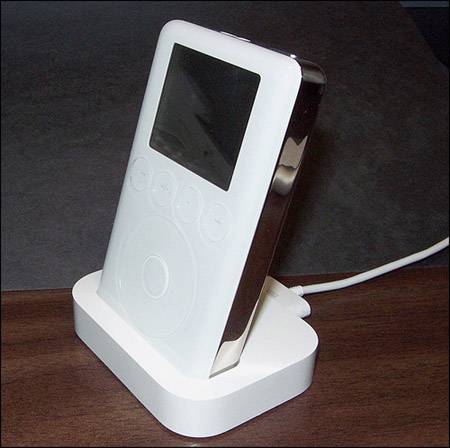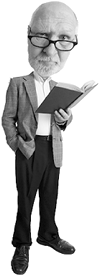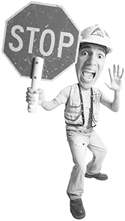| note  | A playlist is a collection of songs. You can use iTunes to create your own playlists and then listen to those playlists on an iPod. There are also a couple of playlists you can create and manage on the iPod itself. You'll learn about these later in this part of the book. |
Dealing with a cable each time you connect your iPod to your computer is a bit of a pain. An iPod Dock provides a cradle for your iPod so you don't need to use the cable itself. When you want to transfer music to the iPod or charge its battery, you simply set it in the Dock (see Figure 2.12). The connection is made instantly and your iPod is updated while its battery charges. Figure 2.12. An iPod Dock eliminates the need to mess around with cables every time you connect your iPod to your computer. 
You can purchase a Dock for any iPod from any retailer that carries iPod accessories or from the online Apple Store located at www.apple.com/store. Even though it doesn't use cables, a Dock is available for the shuffle, too. This is useful when the USB port on your computer isn't convenient for you to reach, such as being on the back of a computer that is under a table or desk. You can place the shuffle's Dock in a more convenient location. In addition to making it easier to connect your iPod to a computer, the Docks for various models also include other ports you might find useful. For example, Docks for iPods (and the older iPod photo models), include AV ports you can connect to a TV to display slideshows on the TV. Additionally, a Dock is the only way to use the better quality S-video connection to display an iPod's slideshows on a TV. Other Docks include an Audio out port you can connect to a home theater to play your iPod's music over a stereo system. tip  | Before you rush out and purchase a Dock, realize that if you use a case on your iPod, you'll have to remove the case to be able to place the iPod into the Dock. Depending on how hard the case is to remove, this might be more trouble than using a cable to connect. Most cases provide access to the Dock port so you can connect the cable directly to the iPod while it is in its case. |
To use a Dock, connect the Dock connector end of the cable you use to connect the iPod to your computer into the Dock connector port on the Dock (instead of the port on the iPod). To connect the iPod to the computer, simply set it into the Dock. When the Dock can communicate with the iPod, you'll hear a tone and your iPod will be mounted on your computer. caution  | Before you pull an iPod out of a Dock, make sure the OK to disconnect message appears on the iPod's screen. |
When you want to disconnect your iPod from the computer, lift it out of the Dock. (You might have to place one hand on the Dock to keep it from lifting up when you lift the iPod out.) The Absolute Minimum Fortunately, a lot of the material in this chapter is useful only the first time you use your iPod. After all, installing software and connecting cables isn't all that thrilling. But it is necessary to do the thrilling stuff that starts in the next chapter. Before we leave this topic, consider the following points: You'll need to install the iPod's software on the CD included with it on your computer. The CD also contains the iTunes installer. However, you might want to download and install a copy of iTunes from the Internet so you are sure you are working with the latest version. To transfer music from your iTunes Library onto your iPod and to charge its battery, you connect the iPod to your computer. You can use a USB 2 or FireWire cable to do this. If you have a shuffle, you plug it directly into a USB 2 port. The first time you connect your iPod to your computer you'll need to do some basic setup. Fortunately, the iPod and iTunes software will guide you all the way. You can install more than one iPod on the same computer. For example, you might be fortunate enough to have an iPod and an iPod shuffle. If have more than one iPod, use a different name for each so you can keep them straight. You can even connect them to your computer at the same time if you have enough ports and cables available to do so. A Dock makes it easier to connect your iPod to your computer. It also includes a Line Out port. You can use this to connect the Dock to speakers or other audio device to play the iPod's music on that device. You'll learn more about this in Chapter 8, "Using an iPod with a Home Stereo or Car Stereo."
|
|
